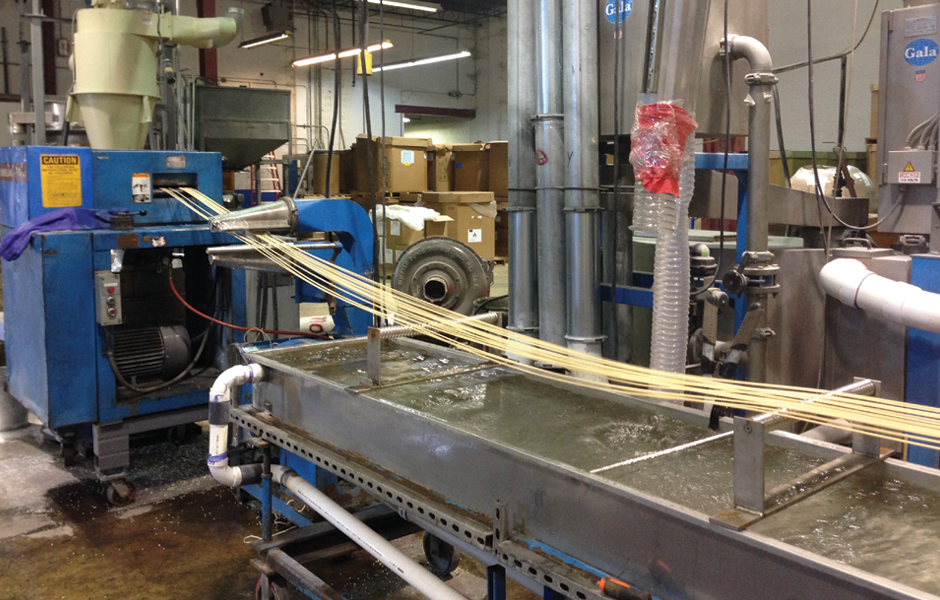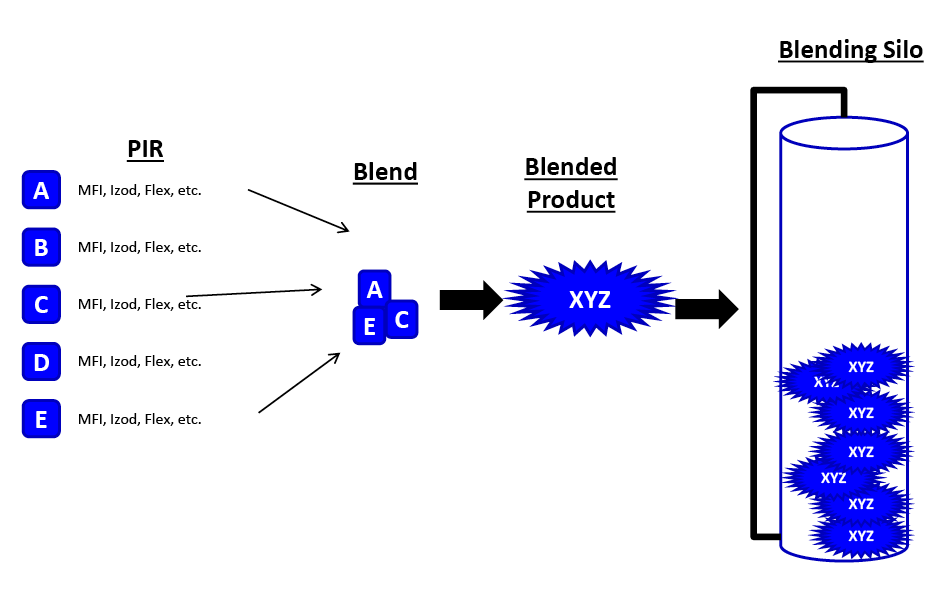Lean & “Green” Compounding
This New Jersey compounder strives for sustainability
Previous Article Next Article
By Jennifer Markarian
Lean & “Green” Compounding
This New Jersey compounder strives for sustainability
Previous Article Next Article
By Jennifer Markarian
Lean & “Green” Compounding
This New Jersey compounder strives for sustainability
Previous Article Next Article
By Jennifer Markarian

A Coperion ZSK series twin-screw extruder with a strand-cut pelletizer produces compounded material at CES.

Above: CES has three silos and a rail siding at its 33,000-ft2 (3100-m2) facility. At right: The company’s compounds containing cellulose fibers provide benefits of lighter weight and reduced carbon footprint.

The properties of multiple types of post-industrial recycled materials are measured in an on-site CES lab, and materials are dry-blended to meet specifications. The finished product is then post-blended for homogeneity, tested to ensure quality, and certified that it meets specific target specs.

An advanced control system continually compares operating parameters to the specifications for a product, and sounds an alarm if there is a process deviation.
Special Handling for Sticky Resins
One of the challenges of compounding TPVs (which are combinations of PP and ethylene-propylene-diene terpolymer (EPDM) that’s crosslinked during compounding) is that the EPDM rubber component can be difficult to handle. CES, however, developed a proprietary technology for dosing EPDM directly to a twin-screw extruder. “This technology provides consistent feeding, which results in consistent viscosity,” notes Kiani.
CES is now using the same system to feed bales of tacky butyl rubber directly to the extruder to make a partially crosslinked butyl rubber–PP compound. “Typically, butyl rubber must first go through a grinding step, which has the potential to introduce metal contamination. After grinding, it is combined with talc to prevent agglomeration before being dosed into the twin-screw extruder and compounded with PP. Our direct feeding system eliminates the grinding step,” explains Russo.
The butyl rubber compounds are used in various applications, including sound dampening in automobiles. A new and growing use, particularly in Europe, is as part of a sealing tape formulation used in the production of polyester wind-turbine blades.
Compounding Engineering Solutions (CES) is a specialty and toll compounder based in New Jersey, USA, that, although a small company, is operating at the cutting-edge of technology in compounding recycled resins.
CES president Arash Kiani has a PhD in chemical engineering and became an expert in twin-screw extrusion while working for Coperion in both Germany and the USA before founding CES in 1999. Peter Russo, vice-president of operations, has 35 years of experience in the chemical industry. During a recent visit from Plastics Engineering, Kiani and Russo shared how the company is using its expertise in compounding in the USA and abroad.
“Green” Compounds Save Money
CES toll-compounds a range of primarily high-end materials, including thermoplastic elastomers (TPEs), thermoplastic vulcanizates (TPVs), reinforced polypropylene (PP), and biopolymers. The company has also developed its own specialty materials; for example, it compounds maleated polyethylene (PE) and PP, using reactive extrusion, for use as coupling agents in wood-plastics composites and glass-filled PP. CES has also applied its technical expertise to prove that environmentally friendly compounds can be “green” in two ways—by reducing a material’s carbon footprint and by reducing its cost in U.S. dollars.
The company began using recycled resin based on a customer’s request to use recyclate to reduce cost, but CES has gone far beyond the common technique of simply adding a percentage of recycle or regrind to a formula. Instead, the company worked with a large recycler that obtains post-industrial recycled (PIR) PP to specify recyclate that could completely replace the virgin PP in their formula but maintain performance.
“Consistency is key,” says Kiani. “We worked with the recycler to specify a consistent blend, because a consistent input plus consistent compounding results in a consistent product. We can ensure that the formula containing recyclate has equivalent MFI (melt flow index), Izod impact, flex modulus, and tensile modulus to the formula made with prime resin.” To obtain this consistency, the recycler analyzes the MFI and physical properties of each lot of PIR and combines lots to obtain a product with the desired properties, which is then mixed in a blending silo before being shipped to CES, which also checks the properties.
Following the success of this recycled PP product, CES developed a method to “dial in” property and cost requirements using a combination of recycled and prime resins and additives. “We have a slate of the most common PIR resins available to our recycler, and we know what properties can be achieved with these. We can therefore tailor products for our customers,” explains Kiani.
The operation produces glass-filled compounds by feeding prime glass fibers into unfilled, recycled PP. The company also created an even greener product using recycled glass. “Processors of glass-filled PP have very few outlets for their scrap beyond using a little as regrind,” says Kiani. CES, however, can use this difficult-to-recycle material, which may contain 40-50% glass fibers, to add glass reinforcement to its compounds. “We can combine our unfilled, recycled PP with recycled glass-filled PP—adding some impact modifier if necessary because the glass has already been through an extruder—to produce a glass-filled PP with good properties and a low carbon footprint, because it uses all recycled resin,” he explains.
CES is currently developing compounds reinforced with renewably sourced cellulose fibers or combinations of glass and cellulose. Cellulose is commonly used for weight reduction, which makes the compounds attractive for automotive applications. “Cellulose is difficult to disperse,” admits Kiani, “But we’re aiming for a completely green product using recycled resin, recycled glass, and cellulose.”
Finding Outlets for Recyclate
Although post-consumer and post-industrial recycling is now well established, one of the challenges is in finding uses for the recyclate locally, to keep the carbon footprint low by avoiding overseas shipping. “The point of failure is often [the] use of recycled material, not collection or preparation,” points out Russo.
Integration between recyclers and compounders seems to be growing, however, with cooperation sometimes extending back even to cities collecting post-consumer recyclate, says Kiani. CES has learned from its experience that integration is a key to success. “It is important to know where your resin is coming from so that you can ensure consistency,” he notes.
Public acceptance of green products is also growing, and with it, the market for recyclate use. Europe is further along, but the market is growing in the USA too. “Ten years ago, no one wanted to use recyclate, but now companies such as automotive suppliers have programs to use it,” says Russo.
The recycling market is also growing in the Middle East, where, in some countries, there is a government push to set up recycling facilities. Kiani acts as a consultant for a company in this region that plans to make railroad ties from post-consumer HDPE reinforced with glass-fiber, using a direct extrusion technology. “This German technology produces high-end railroad ties because it was designed for high-speed rail specification,” notes Kiani.
The project involves taking the local city’s mixed-stream recyclate, separating out the HDPE, and grinding it in preparation for compounding and extrusion. “This project will use 100 million pounds [45 million kg] of HDPE a year. That’s an outlet for a lot of plastic waste,” he adds.
“Building in Quality”: Advanced Process Control
Although CES uses second-hand resin in some of its products, it applies the same philosophy of “building in quality” to all its products, and it operates under ISO 9001. In its 33,000 ft2 (3100 m2) production facility in Clifton, New Jersey, with a capacity of 20 million lbs/year (9 million kg/year), CES operates two ZSK Mega twin-screw extruders with up to seven loss-in-weight feeders on each line.
Quality is built into compounds using advanced controls that continually compare operating parameters to the specifications for that product. “If a parameter such as pressure or torque has a deviation out of specification, an alarm sounds and the line operator takes a corrective action to bring the process back in spec,” explains Kiani. He boasts, “In 15 years of operation, we haven’t had a single lot come back for poor quality.”
CES is now taking the next step to go “beyond Six Sigma, and be predictive rather than reactive by using model predictive control,” he adds. Model-predictive control (MPC) involves modeling a process using experimental data and characterizing the material in real time using online analytical instruments such as color sensors and near-infrared spectroscopy.
“MPC will be very valuable for recycled materials, where the raw material specifications can vary. Using the model predictive control technology, a database of finished product properties compared to process and raw material properties can be made to allow the MPC to predict and adjust the process parameters to obtain specific target properties for finished compounds,” Kiani explains. CES is in the initial stages of this project and hopes to implement this type of control system in the next year or two.
A Global Technology Partner
CES has experience with compounding more than 60 different types of resin, and the company’s flexible extrusion setup allows it to have a variety of extruder and feeding configurations, including loss-in-weight liquid feeding capability. It’s worked with large U.S. compounding and chemical companies and has relationships with technology developers in Germany, and many of its customers are based in Europe. “We work with companies who want to source compounds in the U.S. but want a supplier that can understand European business culture and values,” says Kiani. “Our goal is to become a technology partner with our customers,” he adds. And with its expertise in high quality, “green” compounding, the company is on its way to doing just that.